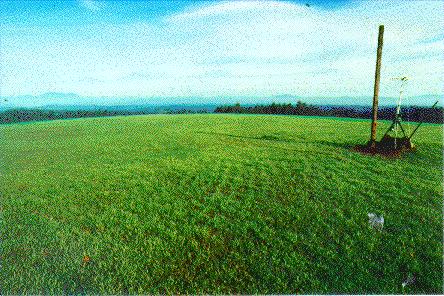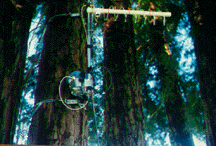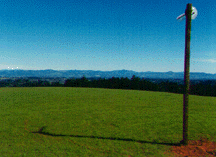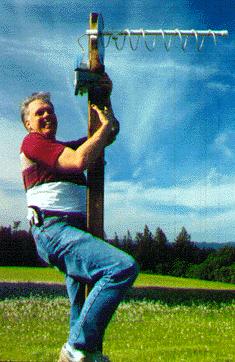
Site Selection
Perhaps the single most important characteristic of an OCAR is its site. An OCAR is most useful when it is located where it can provide line-of-sight (LOS) or near LOS paths to all users . However,. In situations where it isn' possible to find a single site which provides this kind of path it may be necessary to install cascaded OCARs. In any case, careful geographic and terrain analysis should be done as the first step in design and construction of an OCAR.
Since amateur OCARs are used for two-way communications, the receive and transmit antennas generally need to illuminate the identical geographical regions with similar patterns. Identical antennas are an obvious choice.
Having the OCAR situated in the geographic center of its users requires antennas which are omnidirectional in azimuth. The necessary antenna-antenna isolation is then most easily attained by mounting the antennas at different heights, one above the other.
It may be better to situate the OCAR to one side of all the users instead. This allows antennas with directivity in both elevation and azimuth to be used and provides more freedom in mounting. Either over-under or side-side or a combination of these mountings may then be used to provide the required isolation. Front-back isolation may be added to these with the benefit that the minima in the antenna's patterns may be used to good advantage.
Side-situating an OCAR has an additional advantage. On shared bands, like 900 MHz, where there may be a number of non-amateur users with limited Effective Radiated Power (ERP), the side mount can help minimize nearby unwanted sources which might have enough signal strength to be repeated at a high level. The side mount allows and requires higher ERP to overcome the extra space loss. This is not a burden on amateur users, in fact it's actually a benefit since directional antennas are beneficial on receive as well as transmit. This can keep the desired amateur signal levels far above unwanted signals, effectively filtering out the unwanted signals.
Centrally located OCARs and OCARs used for trunking or interconnecting different user groups may need to use dual-beam antennas. These patterns are tailored to fit the need. These can be fabricated from two directive antennas pointed in different directions and fed from a power splitter or coupler.
Our Site
Here in Northern California we are using a location which although not high level, only ~700 feet ASL, still provides good visibility to its users. It is a side-located OCAR and is to the west of all anticipated users. Here is a picture of our OCAR site located about 10 miles west of Santa Rosa, CA.

The partially installed transmitting antenna can be seen to the right. The picture is being taken from slightly in front of the receive antenna.
 Along
with placing the transmit antenna near the first null of the receive antenna
pattern, absorbtive loss from these trees around the receive antenna provides
extra isolation between the antennas and allows more OCAR gain without
risking instability.
Along
with placing the transmit antenna near the first null of the receive antenna
pattern, absorbtive loss from these trees around the receive antenna provides
extra isolation between the antennas and allows more OCAR gain without
risking instability.
 The
installed OCAR transmitting antenna. Measured isolation between these two
antennas separated by about 75 feet is 85 dB.
The
installed OCAR transmitting antenna. Measured isolation between these two
antennas separated by about 75 feet is 85 dB.
 N6GN adjusting the OCAR transmitting antenna.
N6GN adjusting the OCAR transmitting antenna.